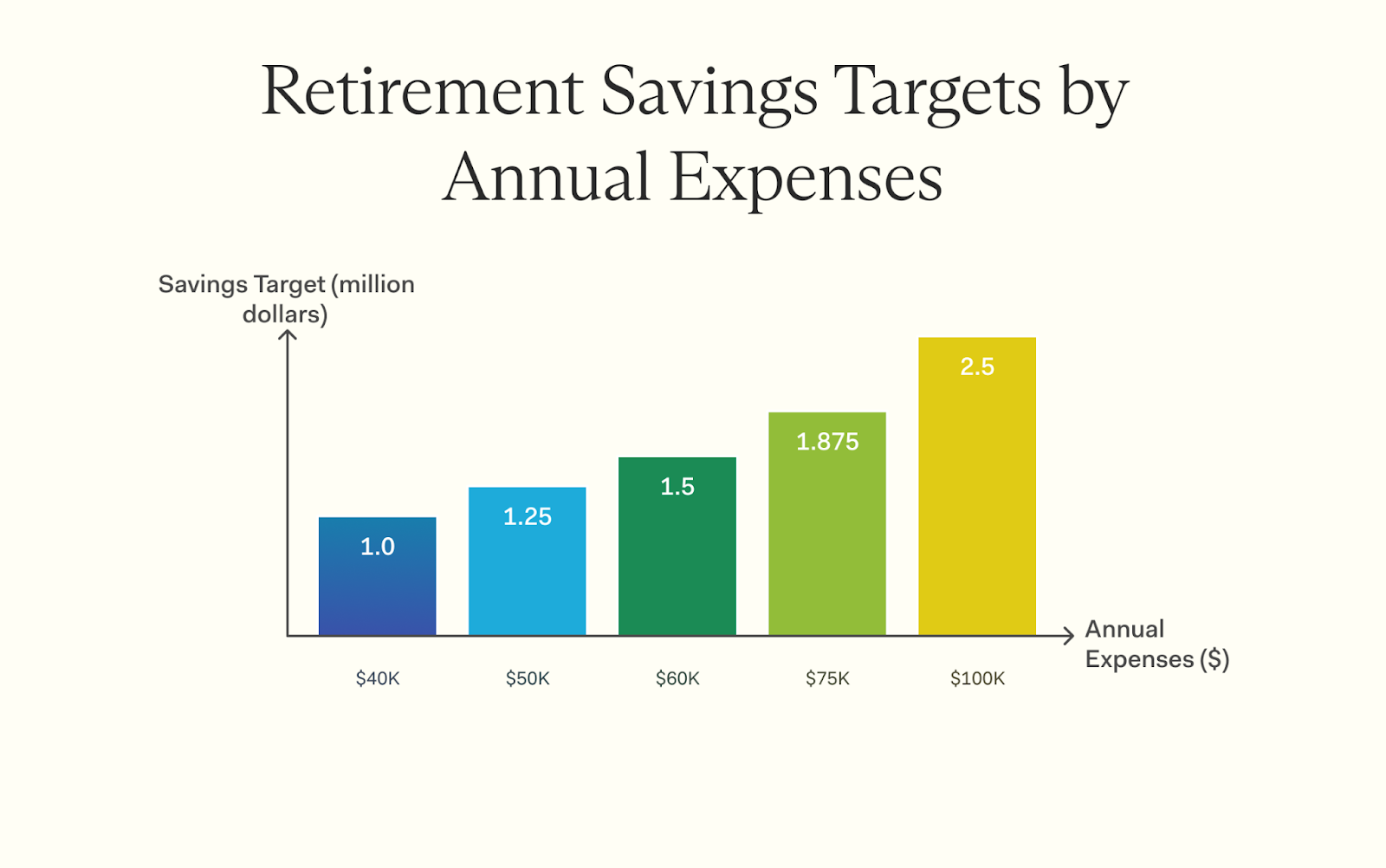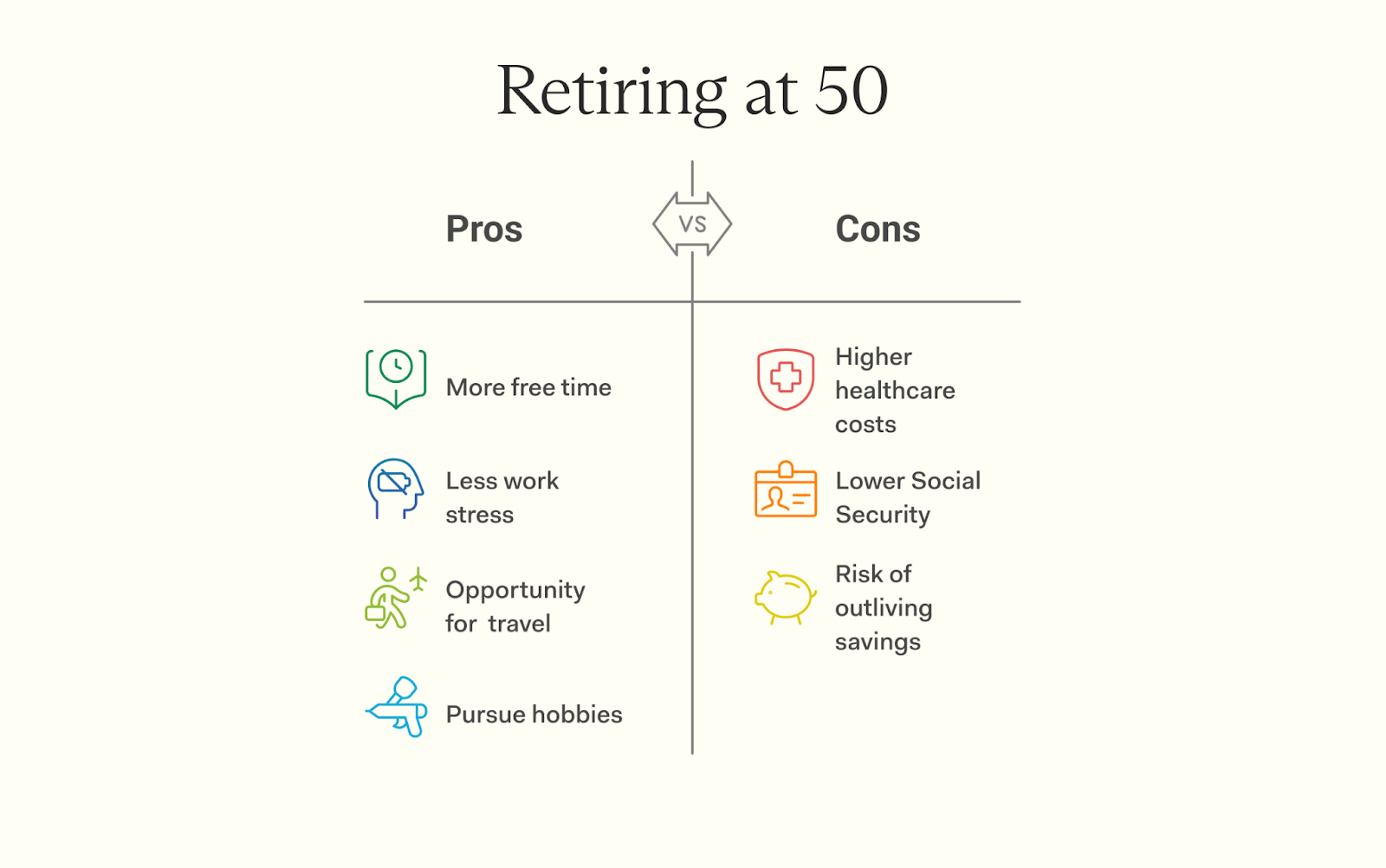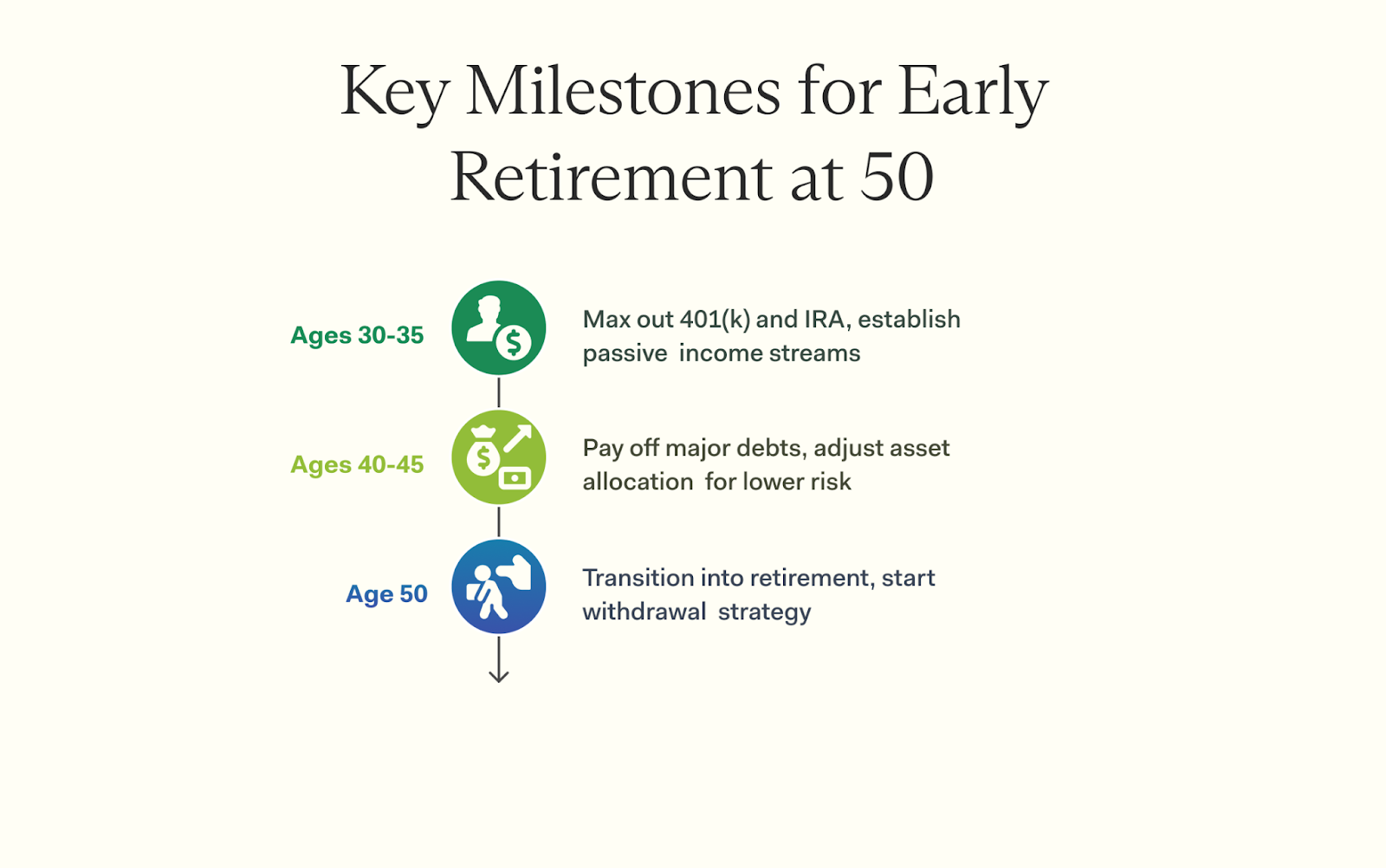Wondering how much you need to retire at 50? Discover essential steps to create a solid retirement plan. Read the article to start planning wisely!
Want to break free from the workforce at 50?
The financial reality requires careful planning—experts recommend accumulating savings equal to 25-30 times your annual expenses. This substantial nest egg creates sustainable income that can support decades of post-career life while accounting for inflation, healthcare costs, and market fluctuations.
This guide walks you through calculating your specific retirement income requirements and developing a strategic early retirement plan.
You'll discover how to effectively leverage tax-advantaged accounts like 401(k)s and IRAs, navigate early withdrawal considerations, and create alternative income streams to bridge the gap until traditional retirement benefits become available.

Effective early retirement planning begins with establishing clear, achievable goals. Start by determining your desired retirement age and envisioning your retirement lifestyle. Do you plan to travel extensively, or are you looking forward to a quiet life in a small town? Your lifestyle choices will significantly impact your financial needs.
Next, estimate your retirement expenses. Consider all aspects of your future life, including housing, food, healthcare, and leisure activities. A good rule of thumb is to aim for 70-80% of your pre-retirement income to maintain a similar lifestyle in retirement.
Here are some steps to help you set clear retirement goals:
Early retirement offers many appealing benefits. It provides increased freedom and flexibility, allowing you to pursue hobbies, travel, and other interests without the constraints of a full-time job.
Early retirement can also improve your health and well-being by reducing stress and giving you more time for exercise and relaxation. It also offers more time to spend with loved ones, creating lasting memories and strengthening relationships.
However, early retirement also presents several challenges. One significant challenge is reduced retirement income.
Retiring early can result in lower Social Security benefits, especially if benefits are claimed at age 62, which results in a permanent reduction of as much as 30% compared to waiting until a full retirement age of 67.
Additionally, healthcare costs can be higher if you retire before 65, as you will not yet be eligible for Medicare. Planning for healthcare is crucial, with options including purchasing private insurance, the Health Insurance Marketplace, or COBRA coverage.
To overcome these challenges, consider the following strategies:

Figuring out how you want to live after you retire is key. Think about where you'll live and the costs that come with it.
Your future lifestyle vision is crucial when planning to retire at 50. If you want to travel or dine out often, you'll need to save more money. Your choice of where to live also impacts how much you need to retire.
Living costs can vary greatly between different places. For example, a beach house in Florida might be more expensive than an apartment in a small town. So, it's important to choose your location and understand its living costs for better retirement planning.
Your location plays a significant role in your retirement costs. Different places have varying living expenses. Housing, food, and healthcare can differ greatly. If you want to retire early at 50, consider where you want to reside.
A modest retirement lifestyle might be easier in a small town compared to a big city.
Additionally, examine the tax implications of each area. Some states have no income taxes while others do. These factors will influence your total retirement savings and funds needed for living comfortably later on.
To figure out your retirement expenses, start with estimating how much you'll spend each year. Don't forget to think about inflation and any rising costs that may come along the way.
Calculating your yearly spending needs is key to knowing how much you need to retire at 50. Start by listing all costs like housing, food, and transportation. Don't forget healthcare expenses; they can be significant before Medicare eligibility kicks in.
Add in fun stuff too—traveling or hobbies that make life enjoyable. Use these numbers to get a clear idea of your future needs. Always account for inflation since costs will rise over time.
Calculate expected income from social security benefits or pension income as well. This gives you a full picture of your retirement funds needed now and later.
Inflation affects your retirement savings. Prices go up over time, so you need to plan for it. Future costs can surprise you too. Think about healthcare expenses, which may rise faster than regular costs.
If you estimate your annual expenses now, you'll need more money later due to inflation. A good rule is to add 2-3% each year as a safety net in your budget. This way, you can maintain your current lifestyle and cover essential needs without stress during retirement years.
Set clear savings goals for your retirement. Aim to save 25 to 30 times what you spend each year. Look at your current savings too. Identify any gaps in what you need versus what you have.
Successful early retirement typically requires savings of 25-30 times your annual expenses. For example, if you need $40,000 a year to live comfortably, you'll want around $1 million saved. This number helps ensure that your money lasts throughout your retirement.
Your retirement income sources will play a key role here. Consider how much you'll draw from accounts like 401(k)s or IRAs each year. Include plans for rental income or other investments too.
Take stock of your current financial position and assess where you stand. Check how much money you have saved in retirement savings accounts like 401(k)s, IRAs, or other retirement accounts. Look at your pre-retirement income too.
Are you close to your savings goal?
Identify any gaps between what you have and what you need to retire at 50. Aim for a nest egg that's 25-30 times your annual expenses. If you're falling short, think about ways to save more money now.
Consider adjusting your savings rate or exploring investment strategies that fit your financial situation better.

Maximize your retirement savings. Contribute to accounts like 401(k)s and IRAs. These accounts have tax benefits that can boost your growth... This is key for early retirees looking to stretch their savings longer.
Making regular contributions to retirement accounts is key for saving. A 401(k) helps you save money from your paycheck before taxes hit. Your employer might also add some extra money, which boosts your savings even more.
An IRA, or Individual Retirement Account, offers tax advantages too. You can choose a Traditional IRA for pre-tax contributions or a Roth IRA for tax-free withdrawals in retirement.
Both options help grow your investment portfolio over time. Make sure to max out these savings accounts as much as you can while you're still working... It pays off later!
Roth IRAs are a smart choice for saving. They allow tax-free withdrawals in retirement. You contribute after taxes, meaning your money grows without being taxed later. This can be a big help for early retirement.
Try to max out your contributions each year. For 2024 and 2025, that's $7,000 if you're under 50 and $8,000 if you're over 50. A good investment strategy includes diversifying where you put this money too—stocks or bonds can work well together.
Keeping your current salary in mind helps set a clear savings goal as you prepare for the future.
Plan for healthcare costs. You need to save for expenses before you qualify for Medicare. Look into health savings accounts (HSAs) too—they can help cover some medical bills tax-free.
Healthcare planning is essential before you qualify for Medicare at age 65. This can be a significant expense. Understand that these costs may include doctor visits, medical supplies, and medications.
You might want to set aside money in health savings accounts (HSAs), which for 2024 have a contribution limit of $4,150 for self-only coverage and $8,300 for family coverage. For 2025, the limits increase to $4,300 for self-only and $8,550 for family coverage. These accounts offer tax advantages and help cover qualified medical expenses.
Your current retirement savings won't last long without careful planning. Think about how much you spend on healthcare each year, even before Medicare kicks in. Setting up a budget now will prepare you better for those years ahead.
Health savings accounts (HSAs) are a smart way to save for medical costs. These accounts offer tax advantages that can help you now and in retirement. You can put money into an HSA before taxes.
This lowers your taxable income.
Withdrawals from HSAs for qualified medical expenses are tax-free. This is a big plus as healthcare costs rise, especially before Medicare kicks in at age 65. It's worth noting you can also invest the money in your HSA for growth over time.
Using HSAs helps to prepare for future expenses, keeping more cash available when you retire early at 50 or whenever you're ready to step away from full- time work.
Set a plan for how much money to take from your savings each year. The 4% rule can be a good starting point, but you might need to change it based on how the market is doing.
The 4% rule helps you plan your withdrawals from retirement savings. It suggests that you can safely take out 4% of your total savings each year. For example, if you have $1 million saved, you could withdraw $40,000 a year.
This rule acts as a guideline for how much money to save and spend.
Adjust your withdrawals based on market performance. If the market does well, you may withdraw more without worries. In poor years, cut back a bit to protect your funds long term. A good strategy will help ensure that your savings last through retirement and into older age. Saving money is key!
Market conditions should influence your withdrawal strategy. Don't forget to review this as market conditions change. If stocks perform well, you might withdraw more. If they dip, consider taking less for that year.
This can help maintain your retirement savings.
Keeping an eye on your investment returns is key. A strong market allows for larger withdrawals without draining funds too quickly. But in tough times, cut back to protect what you've saved.
Being flexible with withdrawals supports a sustainable income during retirement. It's all about balance!
Explore different ways to make money. Think about rental income or starting a small business.
Rental income can boost your retirement savings. Owning property allows you to earn money while you sleep. You might buy a house or condo, then rent it out. This brings a steady stream of monthly income.
Side businesses are another way to grow your funds. Turning hobbies into cash can make a big difference. Whether it's freelancing or selling crafts online, every dollar counts in saving for retirement.
Find what works for you and get started!
A thoughtful approach to Social Security can boost your monthly payments. If you wait until age 70 to start, your benefit could increase by up to 8% for each year after full retirement age.
This means more money in your pocket later on.
Plan wisely if you're considering this option. Analyze your pre-retirement income and expenses. Calculate how much you'll need before Medicare eligibility kicks in. Talk to a financial planner about the best strategy for you.
A good plan helps secure those tax-free withdrawals when you finally do retire.
Find a financial planner to help you map out your plan. They can guide you through savings, investments, and all those tricky numbers. It's smart to have someone watch over your money plans as you get closer to retirement.
A personalized retirement plan is key to retiring comfortably. Start by assessing your financial goals, like how much money you need each year. You may want to start with considering a general guideline of saving 25-30 times your annual expenses, but this should be adjusted based on your specific circumstances, such as expected retirement age and lifestyle.
This helps cover costs as life expectancy increases.
Next, work with a financial advisor for expert guidance. They can help track your progress and adjust investments regularly. Use tax-advantaged retirement accounts like 401(k)s and IRAs to maximize savings.
Careful planning now makes it easier later...especially with healthcare costs before Medicare kicks in. Think about using health savings accounts (HSAs) too!
Regular portfolio reviews are essential. Markets change, and so do your needs. Check your asset allocation often. Make sure it matches your goals for retirement. You might need to shift money between stocks and bonds.
Look at fees too—high costs can eat into savings. Wisely use tax-advantaged retirement accounts like 401(k)s or IRAs for better growth.
They also ensure that you're on track to meet your target savings goal of 25-30 times your annual expenses.
Planning for retirement at 50 requires strategic foresight. Start by defining your lifestyle and calculating costs. Aim to save 25-30 times those expenses. Contribute to tax- advantaged accounts like 401(k)s and IRAs.
Don't forget about healthcare; prepare for costs before Medicare kicks in.
Consider other income sources too—rental properties or a side hustle can help. Working with a financial planner adds value; they can customize your plan to fit you. Have you reviewed your savings lately?
Taking these steps can lead to better financial health now and later on! Saving today secures your future tomorrow, so take action!
Your retirement savings should be enough to replace your pre-retirement annual income, considering the sustainable withdrawal rate. This amount varies depending on personal finance factors, but careful financial planning can help determine this. While a general guideline is to save 25-30 times your annual expenses, individual circumstances such as expected retirement age, lifestyle, and other income sources should tailor this target.
Tax-deferred retirement accounts like traditional IRAs and 401(k) plans offer deferred tax growth while withdrawals are generally taxable and could be penalized if taken before age 59½. Brokerage accounts are taxable and do not inherently offer tax benefits on withdrawals.
Yes, pension benefits can provide a stable source of income for your retirement as they are typically defined benefit plans that aren't subject to the same market risks as contributions to plans like 401(k)s or IRAs.
A good starting point is using a retirement calculator. It considers variables such as current age, expected annual income during retired life, and calculates an estimated amount you'd need to save for retiring at 50.
Taking on personal loans can increase debt obligations and interest payments, which may negatively impact your ability to save for retirement. It is generally more beneficial to focus on maximizing contributions to tax-advantaged accounts.